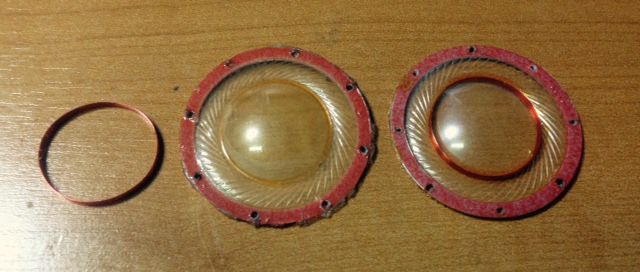I would guess 90% of the broken MD421 are due to the problems in the diaphragm.
Possible and normal diaphragm problems in these mics:
- Diaphragm has metal dust or metal particles on top
- Diaphragm has unglued itself on the sides/extremities
- One end or both ends of coil wire (glued to diaphragm) are broken
- Diaphragm is ripped, has holes or it's scratched
- Voice Coil unglued from the diaphragm
- Diaphragm is ripped were the voice coil is glued
Most people think it's normally a problem in the capsule, but actually the capsule is quite sturdy, the problem lies normally in just one part of the capsule that is the "diaphragm with the small coil"
If we could just get replacement diaphragms for these mics (the voice coil wires with a nice length for soldering) we could probably easily repair most of 421/521 microphones, being it vintage or modern ones.
It let me to start thinking how could we get new replacement diaphragms.
The most easy one would be if Sennheiser sold the diaphragm only has a repair part, but they will not do it because the company doesn't have any interest in people repairing their 40 and 30 years old mics, they want people to buy their new mics.
Another option, and that we would need a lot of luck, was to know or meet someone that works in the current factory (best even if it was in the assembly line) that does the modern 421 capsules, and that person would get us 50 to 100 diaphragms from the factory before they were glued to the capsules. (The unity cost of one of this diaphragm at the factory is completely marginal off course 100 is not, but still not expensive)
That would be possible if we knew someone there, but it's just an imagination at the moment.
The Last option, and actually I think is viable, is to find a factory that produces OEM dynamic capsules diaphragms, I would imagine nowadays it must be somewhere in China, and ask them a quote to reproduce this diaphragm. I guess we would need to order a high quantity but it's totally possible as this diaphragm is quite simple.
Does anyone around here have contacts of OEM dynamic capsule/diaphragm factories or companies in China?
Give me your thoughts
Thank you








![Soldering Iron Kit, 120W LED Digital Advanced Solder Iron Soldering Gun kit, 110V Welding Tools, Smart Temperature Control [356℉-932℉], Extra 5pcs Tips, Auto Sleep, Temp Calibration, Orange](https://m.media-amazon.com/images/I/51sFKu9SdeL._SL500_.jpg)




























